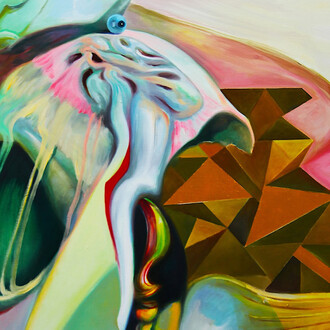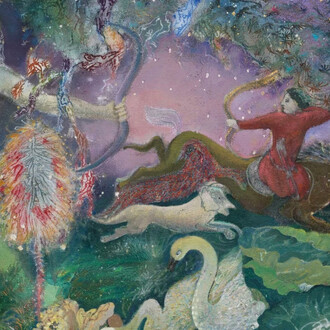Arguments about true human nature are a cornerstone of the Western philosophical canon. Optimists like John Locke believed life before governmental rule was a magnanimous paradise, while pessimists like Thomas Hobbes believed life before a ruler was “nasty, brutish, and short”. Washington-based miniaturist Abigail Goldman leans begrudgingly towards the latter. Her latest solo exhibition, State of Nature with Hashimoto Contemporary, explores the brutal impulses typically suppressed in everyday life on a 1:87 scale. Goldman uses her bloody miniature dieoramas not to shock but to present complex and seemingly absurd narratives of human compulsions that bubble below the surface.
Beyond the usual empty fields or rocky cliff sides, Goldman’s newest narratives of humans in their brutish natural state occur inside picturesque homes, fine dining restaurants, and even Buckingham Palace. Figures no larger than a pinky-fingernail spill and ooze blood, consume human flesh, and execute their houseguests among pleasant interiors. Perhaps due to their size or the elements of surprise, the gory incidents are laced with dark humor. There’s always something funny about elderly women in their Sunday finest breaking from expected composure. Goldman imagines these images of ordinary, respectable people lashing out or giving into their urges as cathartic—it’s something you didn’t know you needed until you had it.
While the exhibition’s title refers to a time before human governance, Goldman clarifies that there are governing forces similar to ours in these miniature worlds. “We’re generally polite. We stand in line. We signal to turn”, she writes. “We mostly follow the rules. But we’re fraying at the edges and a certain kind of madness is setting in. If people find any truth in my work, perhaps it’s seeing subterranean feelings suddenly come to the surface”. Goldman’s work is brutally honest about taboo violent fantasies buried under social contracts. With charm and remarkable craftsmanship, the artist invites us to wonder about our own actions without state rule and underscores our choices when the world is foregone into chaos.
Abigail Goldman’s artistic practice centers around miniature scenes of gruesome murders in plastic and acrylic. Dubbing her works "die-o-ramas", Goldman's miniature sculptures are rendered in 1:87 scale-each tiny figure is well under an inch tall, making them grotesque but familiar, grim but cute. The work's diminutive size contrasts with the larger-than-life tableaus of gore and mayhem rendered within. Though many of the narratives in Goldman's scenes seem like something pulled from fiction, the artist draws almost exclusively from her professional life, where she witnesses and researches the "escalating feedback loop of rage and violence" present in American culture. At once adorable and offensive, Goldman's die-o-ramas explore our relationship to violence-its omnipresence and resulting banality, as well as our innate attraction to the grisly and macabre.
Goldman's miniatures have been exhibited nationally and internationally, and her work has been featured by numerous media outlets, including the LA Times, New York Times, NPR, Atlas Obscura, Juxtapoz, and Huffington Post. In March 2019, Goldman and her work were the subject of a documentary produced for Topic Magazine.
















